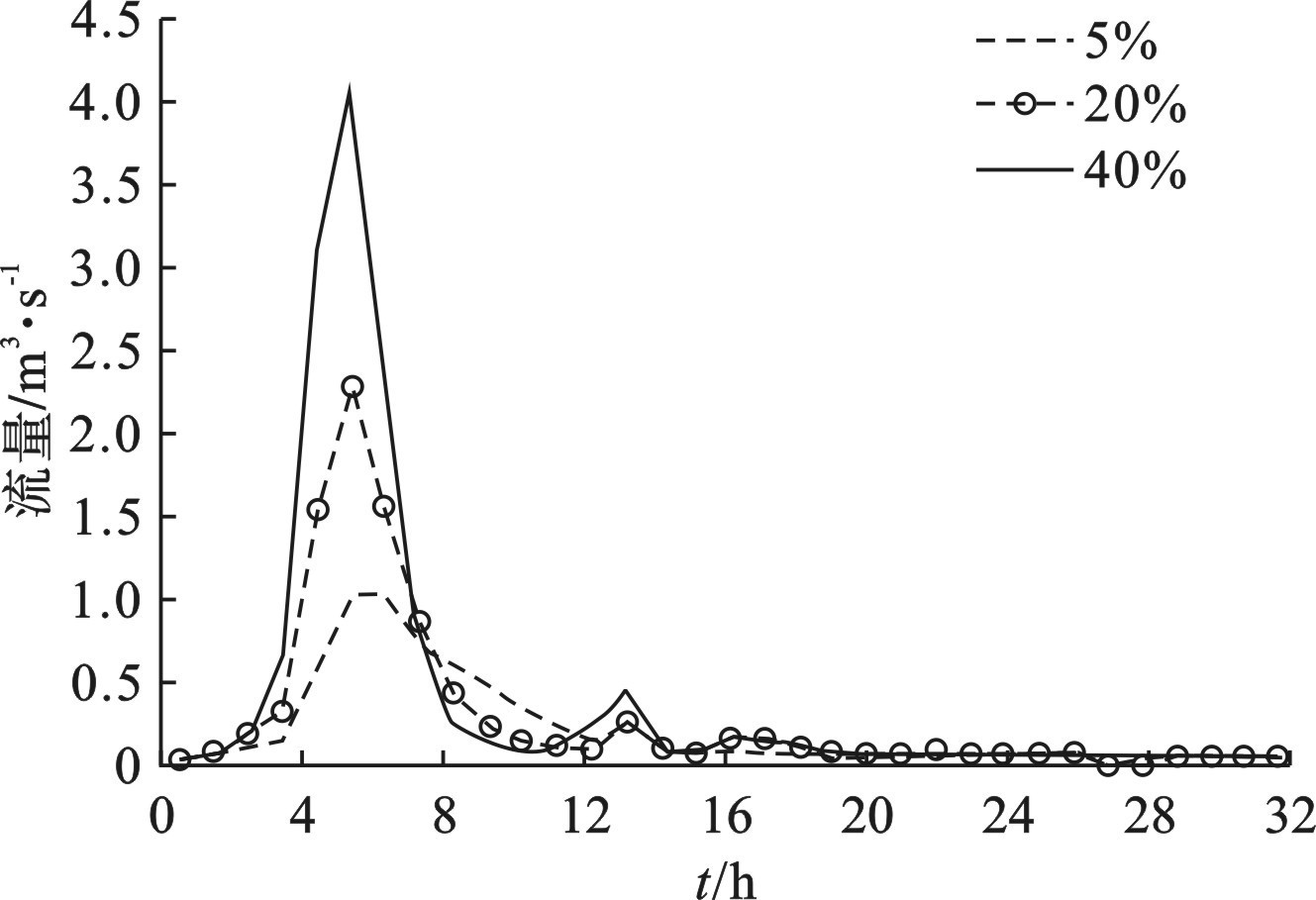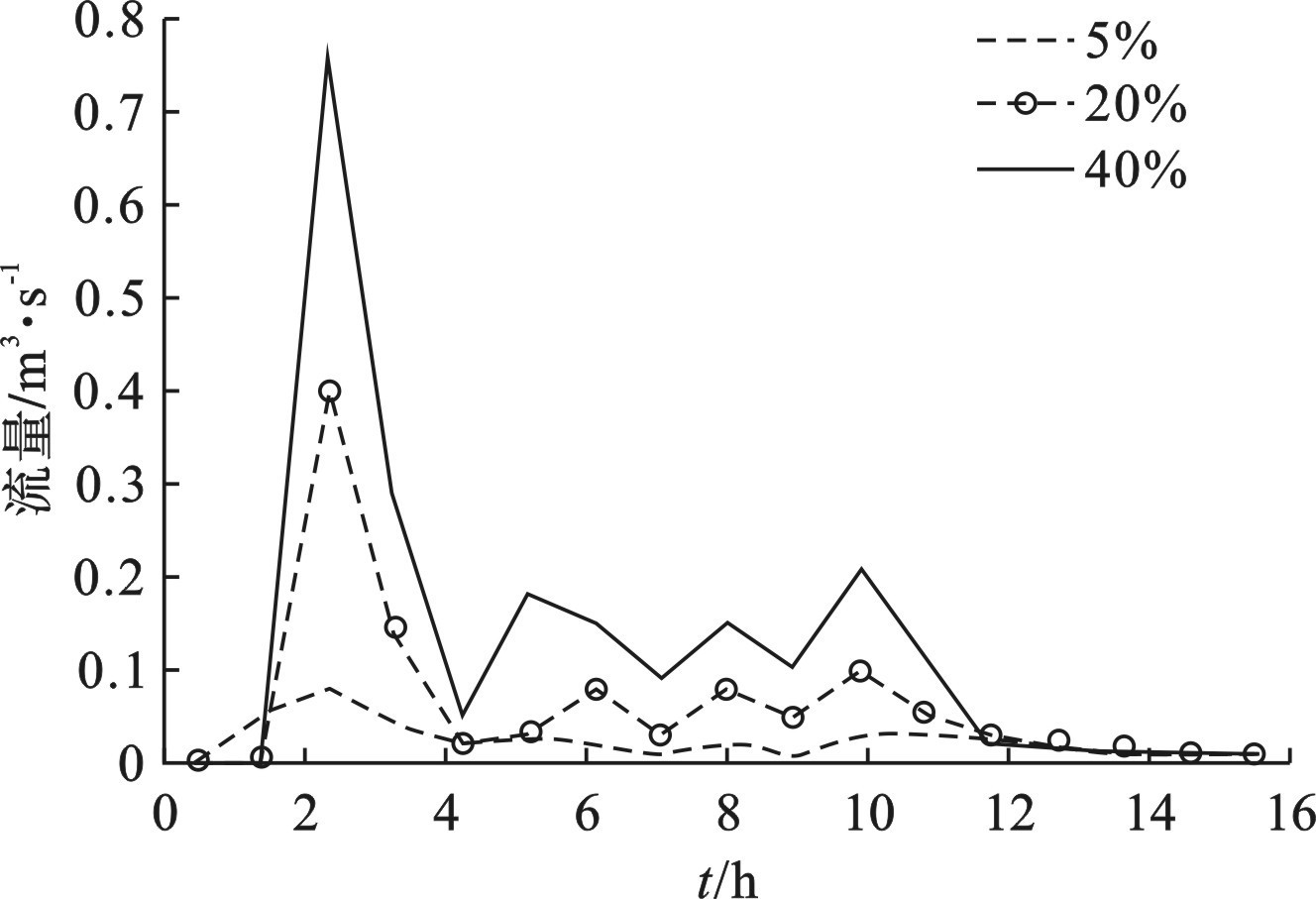-
近些年我国处于快速的城市化进程,城建区域扩张带来下垫面不透水面积显著增加,降低了土壤入渗率,进而对城市水文特征及所在流域生态环境带来较大影响甚至严重干扰[1-3]。如,对城市河湖水系的改造破坏了原有自然水循环过程,引发洪涝与面源污染问题,由于缺乏蓄滞洪区等设施,暴雨-径流过程线更加尖瘦,内涝成灾阈值降低。有研究从定性角度分析了城市化对雨洪的影响[4-5],城市内涝是极端降雨事件、下垫面改变及城市排水能力共同作用的结果,不能仅归因于城建区域扩张,因此,探讨城市化水平对不同重现期降雨的水文响应,对认识城市洪涝灾害的发生机制及启发雨洪调控系统设计具有指导意义。
分布式水文模型SWMM(Stormwater Management Model)自20世纪70年代开发至今已发展到SWMM Version 5.1,增加了低影响开发措施(low impact develpoments,LIDs)的处理能力,为海绵城市建设提供了技术支持[6],包括水文、水动力和水质模块,用以模拟城市降雨径流及污染物迁移过程,应用于暴雨洪水与排水系统的模拟设计和管理,例如可以分析不同重现期降雨下LIDs的城市水文调控性能[7]。吴沛霖等[8]利用SWMM进行了张家港3种暴雨重现期的防涝风险等级评估;李志一等[9]利用模型中的“累积-冲刷(Buildup-washoff)”模块分析了异参同效现象。本研究以一个典型城市化小区为例,基于SWMM模型,通过改变其不透水性系数来模拟不同城市化水平,采用不同重现期的单个降雨事件,从流量过程线的形状、入渗量、地表径流量、洪峰流量和径流系数等方面来揭示城市化发展对不同重现期降雨的水文响应,为强化完善城市内涝应急管理提供支持。
-
模型将划分后的子汇水区(Sub-catchment)作为计算单元,输入气象、地表和含水层等参数对水量水质进行动态模拟,其中水文模块包括产流及汇流模型,利用Horton下渗公式进行入渗计算,圣维南方程进行产流计算,非线性水库进行汇流计算,即联立求解曼宁公式和连续方程。出流量包括地表径流、蒸发和下渗[10],见式(1~2):
式中,Q为出流量,m3/s,B为漫流宽度,m,n为曼宁系数,R为水深,m,Rp为地表水深,m,S为坡度。
式中,V为地表积水量,m3,t为时间,s,F为子汇水区面积,m2,i为净雨,mm。本研究小区属于一快速城市化发展的典型代表小区,面积为0.36 km2,不透水性系数为40%,近些年来该城市处于非城市化向城市化发展的过渡阶段,对其流域水文循环造成了明显的影响。此外,该区域为SWMM模型中一个比较独立的子汇水区,前期研究已建立了SWMM模型并根据实测数据进行了校准和验证[11],也可节省资料收集及模型构建时间。
-
不透水地面覆盖度是一个地区城市化进度和城市生态系统的重要指示因子,下垫面状况改变必然导致径流过程的变化。在SWMM中,土地利用变化对径流的影响由该区域透水性区域积水深度、不透水地表面积比例和曼宁糙率系数来表示,模型参数设置,见表1。
表1可知,透水性区域可积水深度0.76 cm,曼宁系数为0.60。假定不透水性系数在5%~40%变化,不透水性系数5%时,表示低强度的人类活动并未引起城区扩张,认为其为天然状态,随着不透水性系数增加,表明城市人口和经济逐步发展,停车场、建筑物和道路等不透水层扩大,原有生态系统也被改变。不透水性系数为40%时,曼宁系数为0.10,可积水深度为0.51 cm[12],并假定曼宁系数和可积水深度均与不透水性系数呈线性关系。
-
对研究小区多年实测降雨统计分析,对雨强、历时和频率分析基础上,分别选取重现期为50、10和2年的降雨事件以模拟不同城市化对单个降雨事件的水文响应。所选降雨事件,见表2。
-
通过设定区域不透水性系数来模拟不同城市化水平[13-14],针对上述3个重现期的降雨过程,从洪峰及时段径流量、入渗量、径流系数和流量过程线来反映其水文效应。入渗量和径流量均采取和降雨量同样的定义,即,以其分布在整个区域上的深度作为代表。
-
重现期为50年的降雨代表历时长、雨强大、总量大的暴雨事件,不同城市化水平的水文效应模拟结果,见表3。
随着不透水性系数增大,入渗量逐渐减少,而径流量呈现增大趋势,不透水性系数与入渗量呈现显著的负相关关系,与径流量、径流系数和洪峰流量均呈现明显的正相关关系,对于同一等级暴雨事件,当不透水性系数为5%时,径流深仅为5.21 cm,当不透水性系数40%时,径流深达到12.25 cm,径流总量是前者的2.4倍,洪峰流量更是前者的近8倍,不透水性系数5%的天然状态下,径流系数为0.265,40%的较高城市化水平下,径流系数达到0.623。这表明城区建设扩张改变了暴雨洪水过程线,土地利用方式的变化使得城市下垫面发生急剧变化,例如透水性的农田及草地转为不透水性道路,不透水层的发展造成土地资源结构的变化,导致城市化地区暴雨径流量与产汇流过程、所在流域水系水动力过程等发生变化,使得城市内涝灾害发生概率增大,对市政排水系统提出更高要求。
分别选择不透水性系数5%、20%和40%进行其流量过程线的模拟,以进一步揭示同一降雨等级下径流过程对不同城市化水平的水文响应。随着城市化水平的提高,流量过程线愈来愈尖瘦,并且峰现时间越提前,表现为陡升陡落的过程,雨洪通过排水管网向河流汇流速度加快,水位激涨,洪峰流量倍增,加大了流域洪水控制难度,见图1。
-
重现期为10年的降雨表示中等降水事件,表4和图2即为该情景下不同城市化水平的模拟结果以及3种不透水性系数下的流量过程线。
表4和图2可知,与重现期50年的降雨事件相似,城市化水平越高,下垫面条件变化对水文过程的影响越显著,其流量过程线越陡,变化幅度越大,径流总量越大,且峰现时间愈提前,但与图150年重现期降雨相比,峰现时间明显滞后。与表3相比,相同不透水性系数时,10年一遇降雨的径流系数较小,但是随着不透水性系数增加,也即城市化水平越高时,其与50年一遇降雨的径流系数差距越小,例如对于不透水性系数30%、35%和40%,后者分别仅是前者的1.19、1.16和1.14倍。
此外,当不透水性系数为25%时,重现期为10年降雨所产生的洪峰流量3.11 m3/s,接近于不透水性系数为5%重现期为50年降雨所产生的洪峰流量3.43 m3/s,表明城市化发展增加了洪峰流量,较小的降雨事件即可演变为较稀遇的降雨事件所产生的洪峰流量,使得城市区径流形成规律发生变化。
-
与重现期50和10年的降雨事件比,重现期2年的降雨为较低等级水文事件,不同城市化水平的水文模拟,见表5和图3。
表5和图3可知,与前2种重现期降雨的水文效应特征一致,即,径流量、径流系数和洪峰流量均随不透水性系数增大而增大,入渗量则随着不透水性系数增大而下降,径流持续时间上表现为50年重现期降雨>10年重现期降雨>2年重现期降雨。该重现期下3种不透水性系数的流量过程线峰现时间均早于重现期50和10年降雨流量过程线的相应时间,这可能是由于重现期2年降雨所产生的径流总量相对偏少,产流汇流历时较短,较快出现峰现时刻。
-
为进一步分析城市化对不同重现期降雨的水文响应程度,以未进行城市化发展时的天然状态为基准期,即以不透水性系数为5%时的模拟结果为基准值,将各城市化水平下不同重现期降雨的径流量、洪峰流量和径流系数与基准值进行比较,见表6。
表6可知,洪峰流量随着降雨重现期的增大,各城市化水平下的增长幅度均有所增大,当不透水性系数为40%时,重现期50、10和2年降雨下的洪峰流量分别为天然状态下的7.90、3.94和3.74倍,表明城市化对洪峰流量的响应幅度是随着降水量的增大而逐渐增大。10年一遇和2年一遇降雨的洪峰流量分别为4.25和1.42 m3/s,天然状态下分别为1.08和0.38 m3/s,两者绝对值均相差较大,但相对值比较接近,可能由于所选降雨事件历时较长,雨强变化不大,对于一般降水事件而言,洪峰流量及其他水文要素呈现出一种相对稳定增长趋势。对于径流系数和径流量而言,各值则表现出相反的规律,表明城市化对径流量和径流系数的响应幅度随降雨重现期的增大而减小。
-
城市内涝的发生是水文特征的变异性、城市化下垫面改变和防洪排涝工程不畅共同作用的结果[15],目前较少从定量角度去研究城市化对内涝灾害的影响。径流量和洪峰流量是洪涝灾害的2个重要指标,前者与城市排涝系统需要处理的总水量有关,后者与排涝系统瞬时处理的最大水量有关。为了揭示城市化背景下洪涝灾害的形成原因,将各城市化水平及不同重现期降水所对应的径流量和洪峰流量从数值上进行对比分析,可得出如下结论:
(1)对于径流量的改变而言,城市化占据主要地位。对于重现期为2年的降水而言,当不透水性系数为40%时,其径流深为0.68 cm,仅为同比重现期为10年降雨的9.1%,虽然城市化对2年降雨的径流量的响应幅度最大,但由于其值较小,对洪涝灾害没有影响。对于重现期10和50年的降雨所产生的径流量进行分析,并将各不透水性系数下其径流深的差值,见图4。
图4可知,随着不透水性系数的增大,这2个重现期的降雨所产生的径流深均呈显著的线性增加趋势,而两者径流深的差值的增长幅度明显缓于径流深的增长速率,表明对径流量的改变而言,城市化所起的作用比重现期更大,但值得注意的是,由于重现期为50 年的降雨或重现期为100 年的降雨本身就属于稀遇暴雨,易使城市发生洪涝灾害。从径流深的数值上进行分析,当不透水性系数为40%时,10 年一遇所产生的径流总量相当于不透水性系数为15%时,50年一遇的降雨所产生的径流总量,表明在城市化背景下,中等程度的降雨事件有可能演变为原本较大程度的降雨事件所产生的径流总量。10年一遇的降雨属于多发频率事件,应作为城市雨洪收集或排涝系统设计的重要调控对象。
(2)对于洪峰流量而言,重现期大的降雨事件是导致产生大洪峰流量的主要原因。对3个重现期降雨在各不透水性系数下所产生的洪峰流量进行分析可知,当不透水性系数为5%时,2、10和50年降雨所产生的洪峰流量分别为0.38、1.08和3.43 m3/s;而当不透水性为40%时,其洪峰流量分别为1.42、4.55和27.06 m3/s,从数值上还是其增加倍数上进行分析均表明,较大重现期的降雨相比不透水性系数而言,对大的洪峰流量起主导作用。其根源在于较大重现期降雨的瞬时雨强要比较小重现期的瞬时雨强大,从而导致较大的瞬时流量出现。
-
以SWMM水文模型为基础,通过改变不透水性系数、透水性区域积水深度和曼宁系数来代表不同城市化水平,模拟了城市化对3种降雨重现期下的水文响应特征,对城市雨洪管理措施实施具有一定指导作用。
(1)城市化水平越高,其入渗量减少,流量过程线形状由平缓变为尖瘦,并且径流持续时间变短,径流系数变大。不透水性系数从5%增加至40%时,50年重现期降雨下的径流系数从0.265增加到0.623,10年的从0.169增加到0.543,2年的从0.042增加到0.328。
(2)同一降雨等级下,随着城市化水平提高,洪水过程峰现时间提前,但对于同一不透水性系数,峰现时间与降水等级之间没有明显规律。此外,城市化对洪峰流量的响应幅度随着降雨量的增大而逐渐增大,对径流系数和径流量的响应幅度随着降雨重现期的增大逐渐减小。洪峰流量作为整个降雨事件所产生的瞬时流量的一个峰值,当降雨量增大时,城市化程度也即地表植被覆盖水平,在其瞬时流量中作用较大。对于径流系数和径流量,当降雨重现期增大,其产生的径流总量虽然也在增大,但其增长速度和城市化增长速度并不一致,从而导致即使径流系数和径流量均增长,但其增长速率较低。此外,本研究所选降雨为历时长、强度低的事件,由于雨强和土壤入渗能力差别较小,从而导致径流系数和径流量的增长速率缓慢。
(3)在快速的城市化进程中,中等雨强事件有可能演变为原先大强度降雨事件所产生的径流总量,表明城市化对径流量的改变占主导地位。气候变化和人类活动强烈干扰下,多尺度、多要素、多过程的城市生态水文效应是未来研究热点之一。
城市化对不同重现期降雨的水文响应分析
Hydrological response of urbanization on rainfall events with different return periods
-
摘要: 研究城市化对不同重现期降雨的水文响应对于揭示城市化背景下内涝灾害的产生机制具有指导意义。以不透水性系数为主要输入参数来代表不同城市化水平,分别选择重现期为2、10和50年3种等级降雨事件,选取入渗量、径流量、径流系数和洪峰流量作为水文指标。通过建立分布式水文模型SWMM,对各重现期降雨和不同城市化水平下的水文效应进行模拟。结果表明:区域城市化水平越高,洪水流量过程线越陡,由平缓变为尖瘦,径流历时变短,径流变化幅度变大,径流系数也越大。重现期50年的降雨条件下,随着城市化水平提高,径流系数从0.265增至0.623;城市化对洪峰流量的响应幅度随着降雨重现期的增大而逐渐增大,对径流系数和径流量的响应幅度随着降雨重现期的增大逐渐减小;城市化发展对径流量的改变占主导地位,而较大重现期的降雨是洪峰流量增大的主要原因。Abstract: Hydrological response of urbanization under rainfall events with different magnitude is important in explaining how the urban flood disaster happens. The imperviousness was used to depict the different urbanization degrees. The 2-year, 10-year and 50-year rainfall events were selected to represent different magnitudes and the infiltration, and the runoff, the runoff coefficient and the peak flow were chosen as the hydrological indicators. Hydrological responses of urbanization under these three rainfall events were simulated by the distributed hydrological model SWMM. Results demonstrated that the higher imperviousness generated steeper flow curves, smaller flow duration time, greater runoff magnitude and runoff coefficient. Under the 50-year return period, the runoff coefficient increased from 0.265 to 0.623 with the urbanization development. Urbanization response to a peak flow rate increased by rainfall return periods while its response to a decreased runoff coefficient and runoff volume. Urbanization dominated the change of the runoff volume, and the rainfall events were the main reason for the larger peak flow rate.
-
Key words:
- urbanization /
- return period /
- hydrological response /
- runoff volume /
- peak flow
-

-
表 1 SWMM模型输入参数
面积/
km2区域宽
度/m平均坡
度/m·m−1最大入渗
率/cm·h−1最小入渗
率/cm·h−1消减
系数0.36 600 2.00% 11.43 0.51 6.5 表 2 不同重现期的单个降雨事件选取
日期 降雨量/mm 持续时间/h 重现期/a 2009-08-15 196.6 30 50 2015-09-12 137.9 19 10 2019-09-03 52.8 21 2 表 3 重现期为50年降雨的水文效应模拟结果
不透水性
系数/%入渗量/
cm径流量/
cm径流系数 洪峰流量/
m3·s−15 13.29 5.21 0.265 3.43 10 12.17 6.32 0.322 6.85 15 11.27 7.46 0.379 10.28 20 9.88 8.61 0.438 13.69 25 8.66 9.83 0.500 17.09 30 7.39 10.31 0.566 20.46 35 6.82 11.12 0.594 23.79 40 6.26 12.25 0.623 27.06 表 4 重现期为10年降雨的水文效应模拟结果
不透水性
系数/%入渗量/
cm径流量/
cm径流
系数洪峰流量/
m3·s−15 10.77 2.19 0.169 1.08 10 9.96 2.99 0.217 1.47 15 9.15 3.82 0.277 1.92 20 8.33 4.67 0.339 2.46 25 7.44 5.56 0.403 3.11 30 6.48 6.52 0.473 3.99 35 5.98 7.01 0.508 4.13 40 5.49 7.49 0.543 4.25 表 5 重现期为2年降雨的水文效应模拟结果
不透水性系数/%入渗量/cm 径流量/cm 径流
系数洪峰流量/m3·s−1 5 1.75 0.09 0.042 0.38 10 1.66 0.17 0.083 0.51 15 1.57 0.26 0.125 0.67 20 1.48 0.34 0.165 0.85 25 1.38 0.43 0.206 1.07 30 1.29 0.51 0.247 1.32 35 1.20 0.60 0.287 1.39 40 1.11 0.68 0.328 1.42 表 6 不同城市化水平的水文指标与天然状态的对比
水文指标 重现期/a 不透水性系数/% 5 10 15 20 25 30 35 40 径流量 50 1.00 1.21 1.43 1.65 1.89 1.98 2.13 2.35 10 1.00 1.37 1.74 2.13 2.54 2.98 3.20 3.42 2 1.00 1.99 2.98 3.95 4.93 5.90 6.87 7.84 径流系数 50 1.00 1.22 1.43 1.65 1.89 2.14 2.24 2.35 10 1.00 1.28 1.64 2.01 2.38 2.80 3.01 3.21 2 1.00 1.98 2.98 3.93 4.90 5.88 6.83 7.81 洪峰流量 50 1.00 2.00 3.00 4.00 4.99 5.97 6.94 7.90 10 1.00 1.36 1.78 2.28 2.88 3.69 3.82 3.94 2 1.00 1.34 1.76 2.24 2.82 3.47 3.66 3.74 -
[1] VICARS-GROENING J, WILLIAMS H F L. Impact of urbanization on storm response of White Rock Creek, Dallas, TX[J]. Environmental Geology, 2007, 51(7): 1263 − 1269. doi: 10.1007/s00254-006-0419-6 [2] WHITE M D, GREER K A. The effects of watershed urbanization on the stream hydrology and riparian vegetation of Los Peasquitos Creek, California[J]. Landscape and Urban Planning, 2006, 74(2): 125 − 138. doi: 10.1016/j.landurbplan.2004.11.015 [3] 宋晓猛, 张建云, 占车生, 等. 气候变化和人类活动对水文循环影响研究进展[J]. 水利学报, 2013, 44(7): 779 − 790. doi: 10.13243/j.cnki.slxb.2013.07.001 [4] 王艳君, 吕宏军, 施雅风, 等. 城市化流域的土地利用变化对水文过程的影响-以秦淮河流域为例[J]. 自然资源学报, 2009, 24(1): 30 − 36. doi: 10.3321/j.issn:1000-3037.2009.01.004 [5] 许有鹏, 丁瑾佳, 陈莹. 长江三角洲地区城市化的水文效应研究[J]. 水利水运工程学报, 2009(4): 67 − 73. doi: 10.3969/j.issn.1009-640X.2009.04.009 [6] 刘彦成. 基于SWMM的低影响开发与管网优化模拟研究[D]. 武汉: 华中科技大学, 2018. [7] 孙艳伟, POMEROY C A, 吕素冰, 等. 基于不同重现期降水的LID措施水文调控性能研究[J]. 农业机械学报, 2016, 47(6): 178 − 186. doi: 10.6041/j.issn.1000-1298.2016.06.023 [8] 吴沛霖, 俞芳琴, 王婷, 等. 基于SWMM的张家港市排水防涝风险评估[J]. 水文, 2020, 40(2): 31 − 37. doi: 10.19797/j.cnki.1000-0852.20190125 [9] 李志一, 谢鹏程, 杜鹏飞. SWMM模型水质模拟的异参同效现象研究[J]. 给水排水, 2021, 47(2): 133 − 139. doi: 10.13789/j.cnki.wwe1964.2021.02.026 [10] 王芮, 李智, 刘玉菲, 等. 基于SWMM的城市排水系统改造优化研究[J]. 水利水电技术, 2018, 49(1): 60 − 69. doi: 10.13928/j.cnki.wrahe.2018.01.009 [11] POMEROY C A, POSTEL N A, O'NEILL P A, et al. Development of stormwater management design criteria to maintain geomorphic stability in Kansas City metropolitan area streams[J]. Journal of Irrigation and Drainage Engineering, 2015, 134(5): 562 − 566. [12] POMEROY C A. Evaluating the impacts of urbanization and stormwater management practices on stream response [D]. Fort Collins: Colorado State University, 2007. [13] MEJIA A I, MOGLEN G E. Spatial patterns of urban development from optimization of flood peaks and imperviousness-based measures[J]. Journal of Hydrologic Engineering, 2009, 14(4): 416 − 424. doi: 10.1061/(ASCE)1084-0699(2009)14:4(416) [14] MORSE C C, HURYN A D, CRONAN C. Impervious surface area as a predictor of the effects of urbanization on stream insect communities in Maine, U S A.[J]. Environmental Monitoring and Assessment, 2003, 89(1): 95 − 127. doi: 10.1023/A:1025821622411 [15] 李超超, 程晓陶, 申若竹, 等. 城市化背景下洪涝灾害新特点及其形成机理[J]. 灾害学, 2019, 34(2): 57 − 62. doi: 10.3969/j.issn.1000-811X.2019.02.012 -




 下载:
下载:




